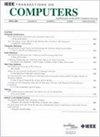Small Hazard-Free Transducers
IF 3.6
2区 计算机科学
Q2 COMPUTER SCIENCE, HARDWARE & ARCHITECTURE
引用次数: 0
Abstract
In digital circuits, hazardous input signals are a result of spurious operation of bistable elements. For example, the problem occurs in circuits with asynchronous inputs or clock domain crossings. Marino (TC’81) showed that hazards in bistable elements are inevitable. Hazard-free circuits compute the “most stable” output possible on hazardous inputs, under the constraint that it returns the same output as the circuit on stable inputs. Ikenmeyer et al. (JACM’19) proved an unconditional exponential separation between the hazard-free complexity and (standard) circuit complexity of explicit functions. Despite that, asymptotically optimal hazard-free sorting circuit are possible (Bund et al., TC’19). This raises the question: Which classes of functions permit efficient hazard-free circuits? We prove that circuit implementations of transducers with small state space are such a class. A transducer is a finite state machine that transcribes, symbol by symbol, an input string of length n into an output string of length n. We present a construction that transforms any function arising from a transducer into an efficient circuit that computes the hazard-free extension of the function. For transducers with constant state space, the circuit has asymptotically optimal size, with small constants if the state space is small.小型无危险传感器
在数字电路中,有害的输入信号是双稳元件误操作的结果。例如,这个问题发生在异步输入或时钟域交叉的电路中。Marino (TC ' 81)表明双稳态元素中的危害是不可避免的。无危险电路计算在危险输入上可能的“最稳定”输出,在约束条件下,它返回与稳定输入上的电路相同的输出。Ikenmeyer等人(JACM ' 19)证明了显式函数的无危险复杂度和(标准)电路复杂度之间存在无条件的指数分离。尽管如此,渐近最优的无危险分拣电路是可能的(Bund et al., TC ' 19)。这就提出了一个问题:哪类功能允许有效的无危险电路?我们证明了小状态空间传感器的电路实现就是这样一类。换能器是一种有限状态机,它一个符号一个符号地将长度为n的输入字符串转录成长度为n的输出字符串。我们提出了一种结构,它将由换能器产生的任何函数转换成一个有效的电路,该电路可以计算该函数的无害扩展。对于具有恒定状态空间的换能器,电路具有渐近最优尺寸,当状态空间较小时,电路常数较小。
本文章由计算机程序翻译,如有差异,请以英文原文为准。
求助全文
约1分钟内获得全文
求助全文
来源期刊

IEEE Transactions on Computers
工程技术-工程:电子与电气
CiteScore
6.60
自引率
5.40%
发文量
199
审稿时长
6.0 months
期刊介绍:
The IEEE Transactions on Computers is a monthly publication with a wide distribution to researchers, developers, technical managers, and educators in the computer field. It publishes papers on research in areas of current interest to the readers. These areas include, but are not limited to, the following: a) computer organizations and architectures; b) operating systems, software systems, and communication protocols; c) real-time systems and embedded systems; d) digital devices, computer components, and interconnection networks; e) specification, design, prototyping, and testing methods and tools; f) performance, fault tolerance, reliability, security, and testability; g) case studies and experimental and theoretical evaluations; and h) new and important applications and trends.
 求助内容:
求助内容: 应助结果提醒方式:
应助结果提醒方式:


